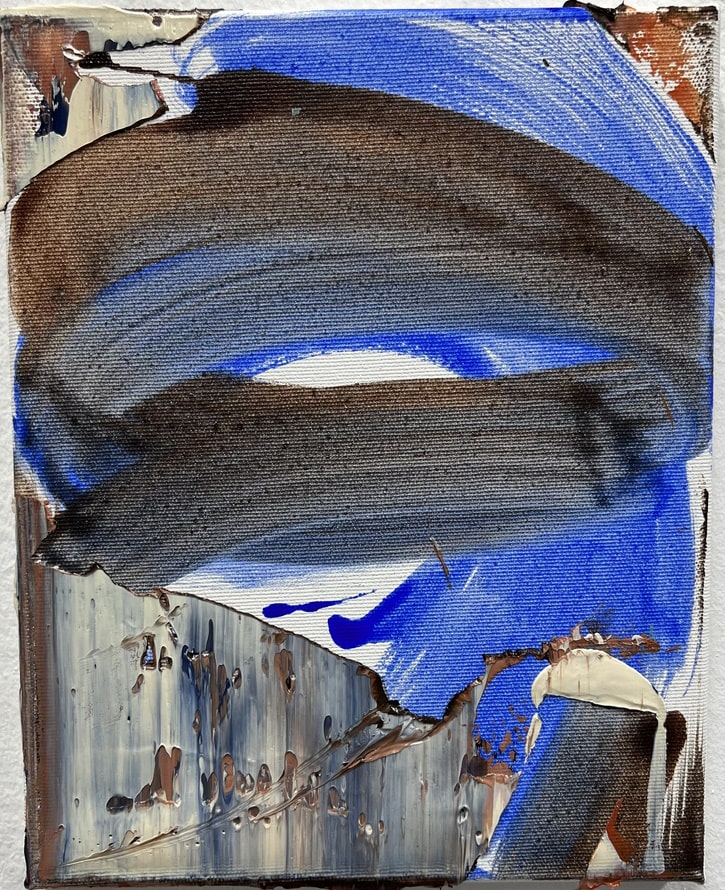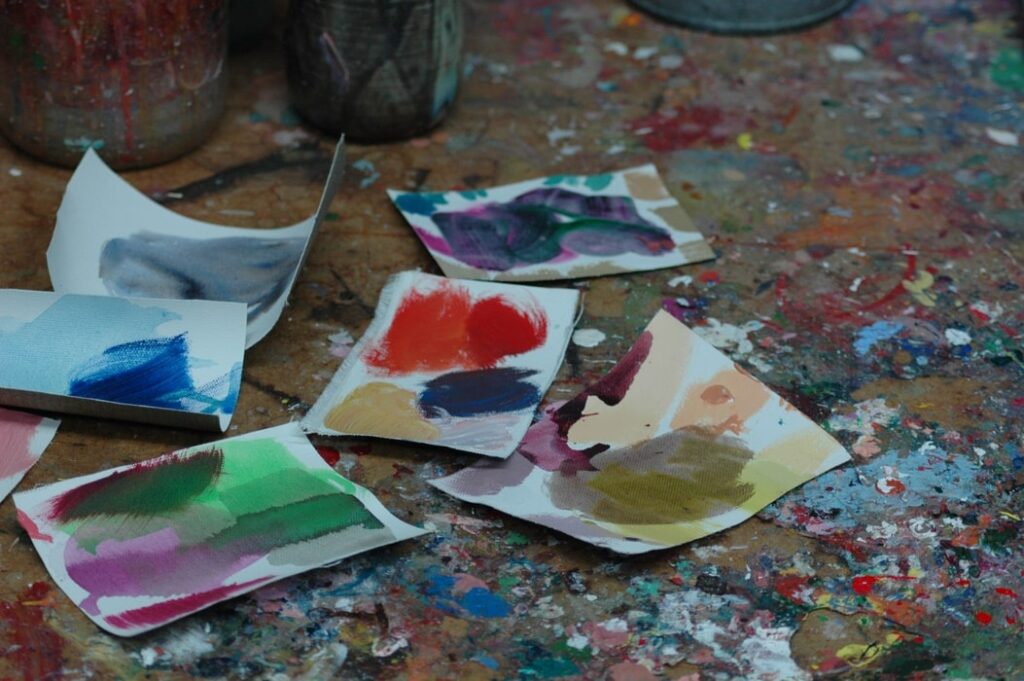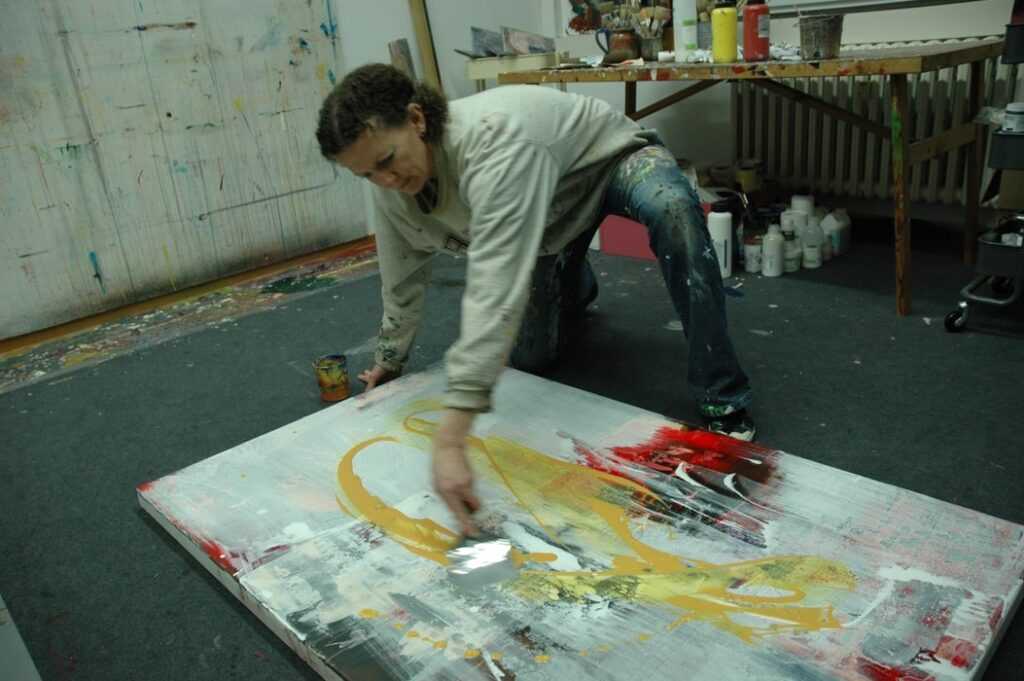PROLOGUE | PERSONAL
Virginia, imagine you would welcome us in your studio or home. Where do we talk together, where do we meet you? We would meet in my studio, a light modern space surrounded by historic buildings on the outskirts of Wetzlar, about 80km from Frankfurt. Perhaps we are sitting in your favourite place? My favourite place is in front the canvas which I’m working on at the moment. You were born in Richmond (Virginia) in the USA in 1969. Today you live and work in Wetzlar, Germany. What stations and people have particularly shaped you in your life so far? My family spent a couple of years in the USA in the late 1960ies and moved back to Germany in the early 1970ies. I grew up in in a small town south of Munich in the “Blue Rider”-countryside. One of my earliest memories is a class trip to the Lenbachhaus in Munich, where I was awestruck by Franz Marc’s “Tiger” and returned to sit in front of it for hours on end with my sketchbook for years after. In retrospect, a kind of “awakening” moment, the first time I remember being lost in the sensation of colour.
Image above: Virginia Glasmacher in her Studio, Wetzlar, 2023

Which writers do you find exciting at the moment and which books can be found on your bookshelf? I love the voices of contemporary female writers such as Meg Wolitzer (The Interestings) and am often drawn to books exploring cross-cultural or gender-identities such as Chimamanda Ngozi Adichie’s Americanah or Bernadine Evaristo’s Girl, Woman, Other. Which books have influenced or shaped you? Many, but these are on my mind at the moment: Martin Gayford’s Man with a Blue Scarf: On sitting for a Portrait by Lucian Freud, Erling Kagge’s Silence in the Age of Noise and the art world documentary The Price of Everything by Nathaniel Kahn. What are you currently reading and where does the book lie at hand? Stolen Focus by Johann Hari is on the shelf next to my bed. What music do you listen to and when? In the studio I listen to classical music (mostly Bach, Chopin, Schubert); when I’m at home my taste is more eclectic & contemporary.

If you were to cook something for us, what would it be? I would probably make something including chickpeas or black lentils, which seem to find their way in to almost everything I make. What is your favourite food? See above, along with butternut squash, French cheese and chocolate. What do you think about breakfast? Small and basic on weekdays, hours on end with family or friends on the weekend. What kind of sport or compensation do you do for your artistic work? I have a yoga mat in my studio, ready to do a few downward dogs or sun salutations on while paint layers are drying. Do you have any special passions (hobbies) that you are passionate about, and if so, which ones? I love to cook and enjoy winding down with a new Ottolenghi recipe after a day in the studio. What personality trait particularly defines you? –

INTERVIEW | ARTIST + POSITION
We would like to briefly introduce your artistic career. From 1989 to 1993 you studied art and semiotics at Brown University in Providence, Rhode Island and art history at New York University in the USA. In 2001 you took part in the International Summer Academy of Art in Salzburg, in Zhou Brothers’ painting class. Did we miss anything? If so, tell us about other stages of your artistic education.
How did you get into art? Why art?
I changed school when I was 16 and spent the last two years at a British boarding school near London. For the first time art class was not about assignments – we were encouraged to work independently in the studio. My art teacher expected us to keep a written journal alongside our studio work and challenged me to reflect in writing on what I was seeing and experiencing. His cryptic and thought-provoking remarks in the margins of my journal and in class along with the freedom to explore set me on my path into the artworld.

What is currently making you happy?
Painting, especially the moment you realise a good painting is done.
What is currently scaring you?
The international political landscape, environmental issues, but I try not to focus too much on things I can’t influence.

Do you believe that art has a social responsibility? And what do you think it can achieve?
Art can play a very important role in raising awareness but this is more relevant for some artists than for others. What I think is more important in terms of social responsibility is that art is made accessible to as widespread an audience as possible through education.
What characterises your art? What is your work about – what are the central themes?
For the past 20 years I have been interested in the interface of abstraction and landscape. The perception and experience of nature are points of departure, from which I build images which can be perceived as “colour-landscapes” or “painting-landscapes”. I am particularly interested in the relationship of the structures and materials (pigments, binders, paint brush/squeegee) and how they define the structure, rhythm and dynamism of the narrative of the image. I work in the tradition of Art informel and the exploration of a broad range of means of expression plays a central role in my work.
THE DEED | DAS WERK: Virginia Glasmacher
Born in Richmond (Virginia), USA, and living in Wetzlar, Germany, artist Virginia Glasmacher (*1969) talks about the central message of her artistic work during her interview.
Please describe the core theme and central message of your work.
My work is rooted in the sensation of colour and the experience of nature. Important reference points are the Expressionists – the artists of Der Blaue Reiter & Die Brücke and the American Abstract Expressionists. In addition, I am interested in the role of chance as a subject of painterly examination. This is of course where the abstract work of Gerhard Richter comes into play.

I am interested in weaving together opposing elements, both on a formal and conceptual level. On the one hand a perception of painting, which is process-oriented and a self-reflexive medium in which the tactile nature of the paint and its texture on the canvas are as tangible as the effects of the colour. On the other hand, I am interested in a pictorial space that discloses references to reality.

Introduce to us the work that you feel exemplifies or best embodies the message of your work.
– I would like to refer to the body of work currently on view at Galerie Kremers, Berlin, images of which you can see here. The two large canvase „Vista, Cadmium Green-Ultramarine” (2022) and “Vista, Ultramarine-Cadmium Red” (2022) show my interest in juxtaposing formal and conceptual paint languages.

Areas with fluid paint washes and gestural brushwork inhabit the canvas together with markings made with artisan tools such as the squeegee or trowel. Emotionally charged mark-making with the brush is juxtaposed with a more neutral, objective mark-making guided by the element of chance. I am interested in weaving together the different languages to form a new identity. In the series of small formats attached here, the confrontation of two paint languages takes centre stage.

What is the goal of your art, of your work – what is it supposed to do for the viewer?
I see my work as a means of giving form to how I experience the world – my surroundings, my experiences, my concerns. It is an offer to the viewer to enter into a journey of reflection and sensory experience. In a sense I offer a space for the viewer to project his/her own experiences and to complete the image in the process of reception.

To end with a quote by Gerhard Richter: “Abstract images are fictional models because they illustrate reality that we can neither see nor describe, but whose existence we can nevertheless infer”.

THE DEED | DAS WERK is a complementary and separately presented part of THE INTERVIEW IN|DEEDS with Virginia Glasmacher.
How do you protect yourself from too much inspiration in today’s times?
I try to focus on what is up next in my studio and on pushing myself to continuously explore and evolve.

How much of your work is planned in advance – how much arises intuitively?
My work is process-based, intuition plays a big part.

What are your (next) goals?
I’m interested in exploring large formats.
What is your position on the subject of faith? Do you have principles of faith or is there a motto?
–
Which project would you still like to realise if a lack of time, courage or financial resources did not play a role?
Good question, maybe a large site-specific work for an architectural space.

In your view, what are the attributes of good art?
Beauty, conceptual or formal rigour.
Is one born as an artist? Or is studying art compulsory?
I think you need a passion, an unquestioned commitment to making art to fuel a life-long artistic journey but formal training is also important.

Who do you show a new work to first?
My husband or my sisters.
What does the first hour of your day look like?
Family duties (sending our two kids off to school) followed by a walk in the forest.

In the age of the Internet of Things, are galleries still necessary? If so, why and for what?
-Galleries definitively still play a very important role in facilitating understanding of an artist’s work and bringing together artists and collectors even if digital channels increasingly gain importance as sources of inspiration.
Social media – blessing or curse?
I think social media is a valuable resource for connecting with the art community around the world. But it takes a lot of will power and discipline to limit time and energy spent online.
EPILOGUE | CURRENT
The exhibition Virginia Glasmacher – New works can be seen from 18. Februar to 25. March 2023 in the Galerie Kremers, Schmiedehof 17, 10965 Berlin–Kreuzberg. The gallery can be reached at info@galerie-kremers.de, Ph: +49 30 46 99 80 68 or cell phone: +49 176 64 72 72 47.
www.instagram.com/virginiaglasmacher
The DEEDS interviews are not edited or shortened by our editorial team and are always reproduced in original sound. Therefore, we do not translate the interview into English or German unless the interviewee submits a translation or we are entrusted with the translation. Here, the English version of the interview was submitted by the artist.





